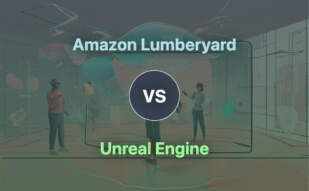For a game engine both powerful and economical, choose Amazon Lumberyard. Providing high-end VR support with AWS behind the scenes, Lumberyard is an optimal choice for developers seeking integration with Twitch. However, if your preference is a more active developer community and language variety, Unity is the choice for you.

Key Differences Between Amazon Lumberyard and Unity
- Amazon Lumberyard is free and cross-platform, offering AWS services and native Twitch integration. Unity requires a per-install fee from 2024.
- Unity provides a rich asset store with pre-designed textures and features, while Lumberyard boasts features like Real-Time Gameplay Editing and the Fur Shader.
- Unity supports a wide variety of coding languages including Boo script, Javascript, and C#; Lumberyard is based on CryEngine.
- Lumberyard is managed by the Open 3D Foundation and adopts Apache 2.0 license. Unity has proprietary software licensing.
| Comparison | Amazon Lumberyard | Unity |
|---|---|---|
| Initial Release | Beta launch on February 9, 2016 | Launched in 2005 |
| OS Support | Microsoft Windows, Linux | Multiple OS compatible |
| Platform Support | Microsoft Windows, PlayStation 4, Xbox One, iOS, Android | Android, iOS and several others |
| Open Source | Yes, under Apache 2.0 and MIT | No |
| Cost | Free excluding AWS usage | Per-install fees applied post January 1st, 2024 |
| Future Development | Under the Open 3D Foundation | Continuous tech evolution and community engagement for problem-solving |
| Concerns | Limitations on public release of its source code or usage for creating own engine | New pricing model causing financial concern among developers, reduced trust due to sudden changes |
| Advantages | Cross-platform, free, 3D modelling tool, AWS services, native Twitch integration, advanced VR support | Diverse pre-designed textures and features, multiple coding languages support, adaptability and collaboration enhancement |
What Is Amazon Lumberyard and Who’s It For?
Amazon Lumberyard, an ex-freeware cross-platform game engine by Amazon Game Tech, is now Open 3D Engine spearheaded by Linux Foundation’s Open 3D Foundation. The powerful game engine comprises AWS integration and Twitch stream support ideal for serious game developers and publishers.
It’s a robust 3D, cross-platform solution working in unison with the Xbox One, PS4, Windows, Linux, iOS, and Android domains. Known for powering titles like New World, Deadhaus Sonata, and The Grand Tour Game, it’s optimized for individuals who demand outstanding VR support and advanced gaming functionalities.

Pros of Amazon Lumberyard
- Seamless cross-platform experience
- Free yet advanced 3D gaming tool
- Tightly integrated with AWS services for backend support
- Robust Twitch integration for user interaction
- Promising VR support
Cons of Amazon Lumberyard
- Charges $1.50 per 1,000 daily active users, plus standard AWS fees
- Limited public release of its source code
What Is Unity and Who’s It For?
An illustrious game development engine, Unity, renowned for creating stellar 3D and 2D games, is ideal for developers craving immersive and cross-platform game creation tools. Its suitability spans across various operating systems, including Android and iOS, aiding the development of a spectrum of applications from AR to 3D simulations.
Unity’s suite of tools, rendering technology, and feature-rich environment caters specifically to developers keen on high-quality game crafting. However, with the new per-install fee structure coming into effect in 2024, it’s facing backlash from indie or solo developers, spurring demand for clarification and accountability.

Pros of Unity
- Robust cross-sector application
- Rich asset store incorporating diverse pre-designed textures and elements
- Supports BOO script, Javascript, and C# programming languages
- Vibrant developer community
Cons of Unity
- Impending per-install fee structure causing discontent
- Unannounced changes compromising developers’ trust
- Concerns of sudden pricing shifts affecting financial sustainability
Amazon Lumberyard vs Unity: Pricing
While Amazon Lumberyard offers its engine at no cost barring charges for AWS usage, Unity adopts a controversial per-install fee model with an additional free version for developers.
Amazon Lumberyard
Initially a freeware game engine, Amazon Lumberyard now operates under an open source Apache 2.0 license and is managed by the Open 3D Foundation. AWS integration forms a significant part of the engine’s architecture, attracting a charge of $1.50 per 1000 daily active users plus standard AWS fees. However, the engine itself, including advanced features like VR support and Twitch integration, comes without royalty charges.
Unity
Unity’s pricing model, set to be implemented on January 1, 2024, levies developers a fee each time a Unity-based game is installed. Despite concerns, Unity has clarified that developers will only be charged an install fee after their game garners $200,000 in revenue and surpasses 200,000 installations. A free version of Unity is available in addition to the paid version with extensive features. However, Unity’s new pricing policy has led to strong backlash from its user-base, especially indie developers.
Code Examples for Amazon Lumberyard & Unity
Amazon Lumberyard
In this sample script for Amazon Lumberyard’s Lua framework, we are going to animate a simple character model. The character is to respond to user prompts, thereby resulting in a defined animation. The prerequisites for our code include the Lua scripting engine and the Amazon Lumberyard environment with an existing character model.
--[[Character Animation Script in Amazon Lumberyard]]
local characterAnimate =
{
Properties =
{
animation = { default = "", description = "character animation", },
},
}
function characterAnimate:OnActivate()
self.animationHandler = AnimationNotificationBus.Connect(self)
end
function characterAnimate:OnDeactivate()
self.animationHandler:Disconnect()
end
function characterAnimate:OnAnimationEvent(eventType)
if eventType == AnimationNotificationType.Stop then
self:PlayAnimation(self.Properties.animation)
end
end
function characterAnimate:PlayAnimation(animation)
local animationParameters = PlayAnimationParameters()
animationParameters.sequence = animation
animationParameters.playbackSpeed = 1.0
animationParameters.looping = true
self.actor:PlayAnimation(animationParameters)
end
return characterAnimateUnity
The following Unity C# example will create an interactive player object that can move in the x and y directions based on user inputs. We’ll utilize the Unity Engine and MonoBehaviour classes. Make sure the Unity Environment is already set up and ready for the new script.
// Player Movement Script in Unity
using System.Collections;
using System.Collections.Generic;
using UnityEngine;
public class PlayerMovement : MonoBehaviour
{
public float speed = 10f;
void Update()
{
float moveHorizontal = Input.GetAxis("Horizontal");
float moveVertical = Input.GetAxis("Vertical");
Vector3 movement = new Vector3(moveHorizontal, 0.0f, moveVertical);
GetComponent<rigidbody>().velocity = movement * speed;
}
}
</rigidbody>Amazon Lumberyard or Unity: Which Reigns Supreme?
Push through the hype and arm yourself with our decisive verdict to choose your ideal game engine.
For Enthusiasts Exploring Open Source
Choosing Amazon Lumberyard might just be your pivotal milestone. It’s open source, under the Apache 2.0 license, pushing free and independent development. Also, its integration with AWS and Twitch, and advanced AR support positions it as your go-to choice.

For Game Makers in the Commercial Space
Avoid hidden cliffs; anchoring on Unity might serve you right. Mindful of its fee-based model with a tilt towards commercial deployments, its support of diverse textures, languages, and continuous immersion in the evolving tech space carves it out as the optimal engine for you.

For Tech Developers Keeping Profit Margins at Heart
If profit margins are your heartbeat, let your pulse align with Amazon Lumberyard. Say no to royalty evils with Lumberyard, embrace no costs excluding AWS usage, and capitalize on Incredibuild’s Virtualized Distributed Processing technology to fast-track outcomes.

AR/VR Creators Seeking for Stellar 3D Visuals
Unity should be your default choice. Its commitment to stimulating and inviting AR/VR highlights, unmatched adaptability, and rich set of tools place it on a podium compared to the competition.

For a broad use case, open source swing, and AWS enhancement, Amazon Lumberyard sits on the throne. Conversely, for commercial deployments, deeper texturing, and elevated language preference, Unity takes the crown. Make an informed choice, adapt to your canvas, and revolutionize your gaming dreams.
Tiffany Brise
Content writer @ Aircada, patiently awaiting a consumer AR headset that doesn’t suck.





